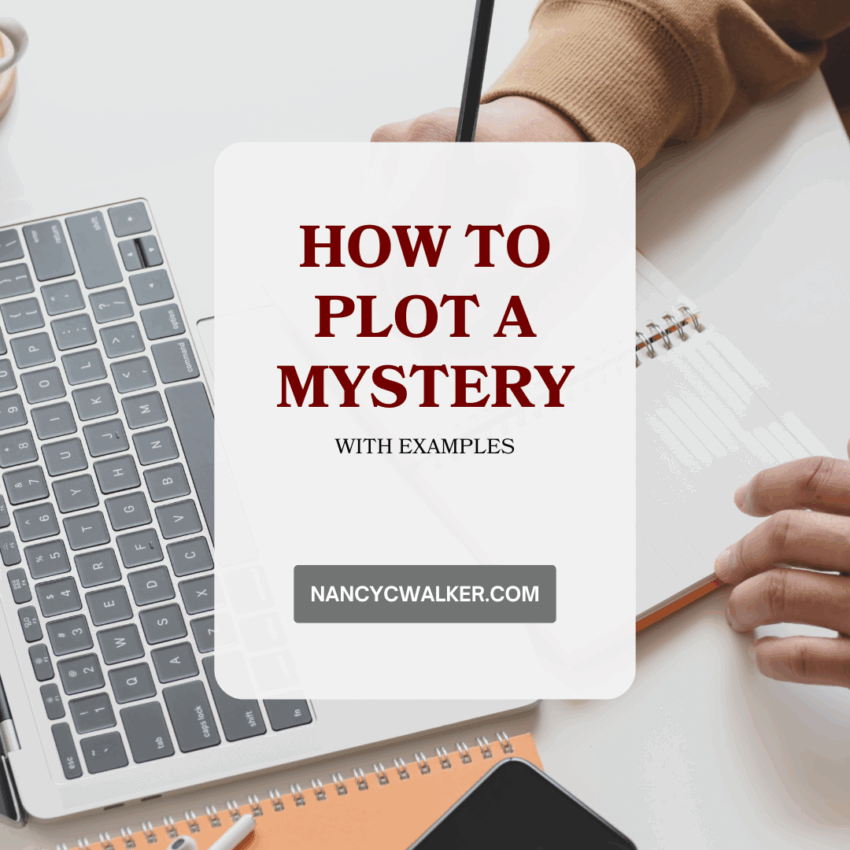This article is part of a series about how you can plot a novel.
My second book was going to be a mystery novel. Then I tried to write one. Writing a mystery novel is all about building an intricate puzzle for your readers, centered on memorable characters and a shocking yet inevitable truth. I had the characters, but the plot kept wandering into black holes of backstories and more twists than a roller coaster. I ended up researching how to plot a mystery novel specifically, and this is what I learned.
Potential spoilers for:
- Gone Girl
- Knives Out
- Sherlock Holmes
- The Silence of the Lambs
- The Girl with the Dragon Tattoo
- Zodiac
- And Then There Were None
- Da Vinci Code
- The Sixth Sense
- The Girl on the Train
- Mystic River
The Core of Your Mystery: Characters and Crime
At the heart of every mystery lies a crime (often murder), masterminded by an opponent determined to get away with it.
The Detective (Your Hero)
This is your reader’s guide, a truth-seeker with a brilliant mind, wit, curiosity, and a relentless drive for justice. Give them a “ghost”—a past failure or trauma that fuels their pursuit of justice and makes them relatable.
Example: Sherlock Holmes (from Arthur Conan Doyle’s Sherlock Holmes series) is the quintessential brilliant detective, often driven by intellectual curiosity. His “ghost” could be his struggle with ennui when not engaged in a case. Hercule Poirot (from Agatha Christie’s novels) is similarly brilliant and driven by order and justice.
The Killer (Your Opponent)
Their sole goal is to evade capture, employing tactics like alibis, framing others, red herrings, and false clues.
Example: The killer in Gillian Flynn’s Gone Girl masterminds an elaborate disappearance and framing, using false clues and a carefully constructed narrative to mislead investigators.
The Setting
The mystery often unfolds in complex settings, where an organized surface can hide a dark underbelly, intensifying the stakes.
Example: The isolated, grand mansion in Knives Out (a modern take on classic whodunits) provides a contained environment where secrets are exposed. The atmospheric, fog-laden streets of Victorian London in Sherlock Holmes also create a distinct backdrop for criminal activity.
Structuring Your Page-Turner
A strong mystery benefits from a logical structure that guides the investigation and reveals the truth.Investigation
Your detective observes evidence, questions suspects with deceptive queries, uses intuition, and recreates the crime to test theories. Each revelation should build tension.
Example: In The Silence of the Lambs, Clarice Starling’s investigation involves a painstaking analysis of evidence, psychological profiling, and intense interrogations to piece together the killer’s motives and methods.
The Three-Act Structure
Act I
Introduce the crime, the sleuth, plausible suspects, initial complications, and a private life subplot.
Example: In The Girl with the Dragon Tattoo (Stieg Larsson), Act I introduces the cold case of Harriet Vanger’s disappearance, the disgraced journalist Mikael Blomkvist, and the enigmatic hacker Lisbeth Salander, along with the Vanger family and their secrets.
Act II
Focus on investigations and interrogations that uncover clues, potentially a suspect’s disappearance, and escalating stakes.
Example: In Zodiac (based on Robert Graysmith’s book), Act II details the painstaking, often frustrating, investigations by the police and the amateur sleuths as they try to decipher the killer’s clues and track his movements, with the stakes rising as more victims emerge.
Act III
Reveal hidden motives, address a false solution, revisit an overlooked clue from Act I, leading to the confrontation with the perpetrator. The killer’s fatal mistake is key, forcing them to make a desperate last effort. Resolve the subplot and consider a self-revelation for your detective or “poetic justice” for the killer. The resolution often involves a shocking confession or a dramatic unmasking.
Example: In And Then There Were None (Agatha Christie), Act III brings the remaining characters to a desperate climax as the killer’s identity is revealed, along with the intricate method of their “poetic justice.”
Essential Writing Tips for Impact
Hook Your Reader Early
Start with an inciting incident—the event that shakes up your protagonist’s world and kicks off the major conflict, ideally around the 12% mark of Act I. This is typically the unveiling of the crime itself. Instead of generic drama, pose an immediate story question that gives the reader a personal stake.
Example: The opening scene of The Da Vinci Code (Dan Brown) with the murder in the Louvre immediately throws the protagonist Robert Langdon into a high-stakes mystery, posing a central question about the victim’s dying message.
Master the Plot Twist
A meaningful plot twist should cause an external shift (rearranging plot elements), an internal shift (emotional impact on the audience), and a philosophical shift (changing perception of the story’s theme). It must be surprising yet feel inevitable in hindsight, built into the narrative with a “hidden shadow structure” of truth rather than outright lying to the audience. Use misdirection to hide the truth in plain sight.
Example: The famous twist in The Sixth Sense (while not strictly a mystery novel, it employs mystery elements) reveals a truth that reframes everything the audience has seen, feeling both shocking and inevitable upon reflection.
Avoid Amateurish Mistakes
- Don’t introduce too many characters in the first chapter; focus on two or three central figures and layer others in slowly.
Example of what to avoid: A novel that introduces a dozen characters with their full backstories in the first few pages, making it hard for the reader to keep track.
- Beware of “as you know, Bob” dialogue, where characters state information they both know for the reader’s benefit. Instead, show backstory organically or use dialogue to create conflict.
Example of what to avoid: “As you know, Detective Smith, this is the third time this killer has struck in our city.” Instead, the detective might look at a map with pins, or react with grim familiarity to a news report.
- Avoid introducing items or skills just before they’re needed; plant them subtly earlier in the story to make them feel organic.
Example of what to avoid: A detective suddenly pulling out a rare lock-picking tool they’ve never mentioned before, just when they need to pick a specific lock. Instead, the tool could have been casually mentioned or seen on their desk earlier.
- Minimize characters talking to themselves aloud (unless a specific trait); use body language, dialogue with others, or internal thoughts.
Example of what to avoid: A detective standing alone in a room, narrating their deductions aloud to an empty room. Instead, their internal monologue could be conveyed through their thoughts, or they could bounce ideas off a colleague.
Pacing and Stakes
Use questions and answers to manage pacing between plot lines, ending scenes with cliffhangers to build suspense. Ensure your story has significant stakes, expanding personal stakes to affect others.
Example: The Girl on the Train (Paula Hawkins) effectively uses alternating perspectives and unanswered questions at the end of chapters to maintain high suspense and keep the reader turning pages, with the stakes continually escalating from personal to potentially life-threatening.
Craft a Satisfying Ending
Avoid endings that are overly sentimental, abrupt, never-ending, confusingly ambiguous, or, especially in a mystery, obvious. Subvert expectations with red herrings to keep readers guessing.
Example: The ending of Mystic River (Dennis Lehane) provides a grim, yet conclusive, resolution to the mystery, while still leaving the characters grappling with the lasting emotional consequences, avoiding an overly neat or sentimental wrap-up.
Writing a mystery is like being a master illusionist. You present an interesting world, lead your audience down a winding path of clues and suspects, all while meticulously hiding the truth in plain sight, ensuring the final reveal is both astonishing and perfectly clear.

